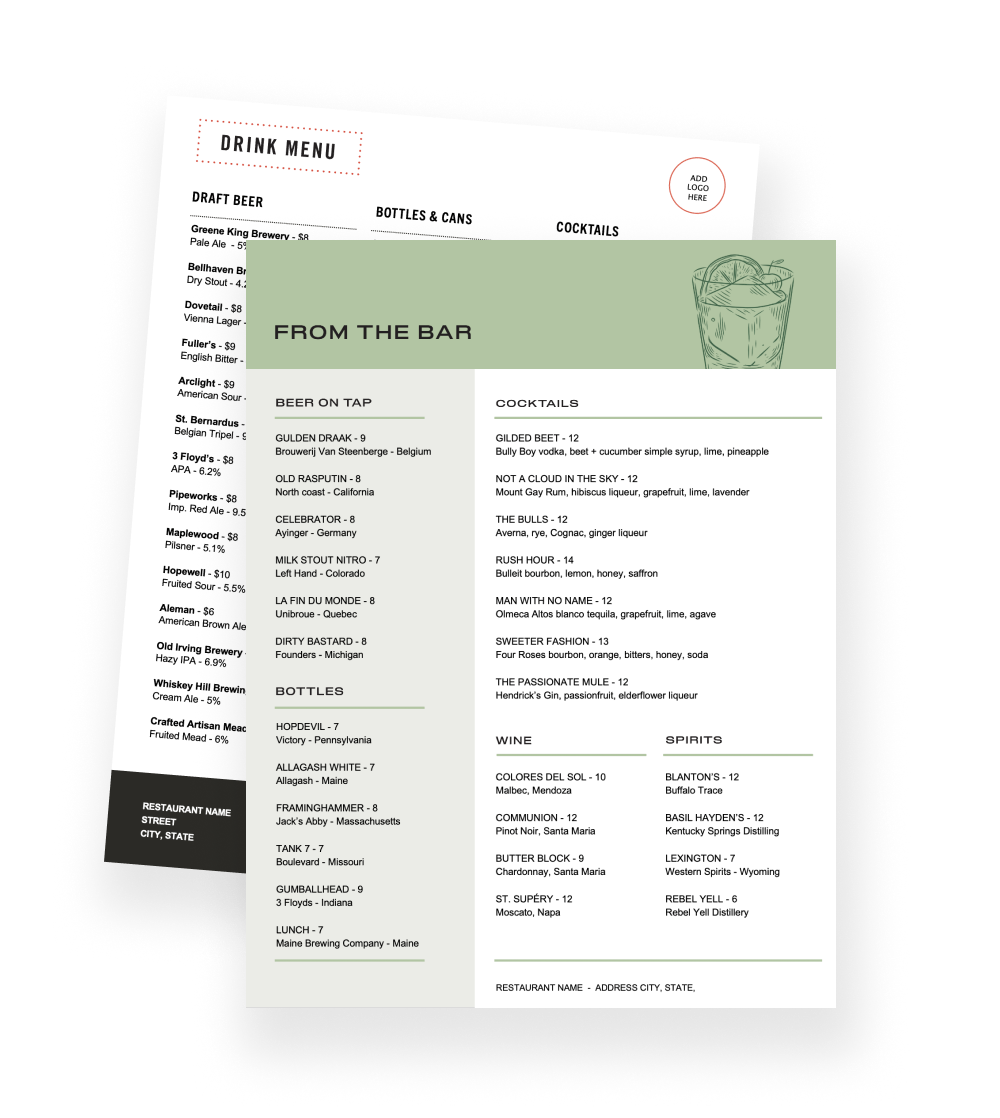
Bar Recipes: How to Develop Bar Recipes [2024]
Here is everything you need to develop your bar menu recipes, from research and development to testing and scaling.

Caroline PriceAuthor


Bar Menu Templates
Use these bar menu templates as a starting point for your menu design or to give your menu a refresh.
Get free downloadBars have long been hubs where people gather to enjoy drinks, socialize, and indulge in delicious bar food. According to an IBISWorld analysis, the bar and nightclub industry revenue has grown at a CAGR of 1.9% over the past five years, to reach an estimated $37.8bn in 2024. This growth provides an opportunity for bar owners to develop new offerings, attract new customers, and tap into a thriving market.
From classic appetizers to innovative comfort food creations, bar menus have evolved to cater to diverse tastes and preferences. This guide will help aspiring bar owners and chefs develop standout recipes tailored specifically for a bar setting, ensuring both creativity and consistency in their offerings.
Menu Engineering Course
Take this course to make the most of your menu. Learn about menu psychology and design, managing your menu online, and adapting your menu to increase sales.

Steps to Developing Your Bar Menu Recipes
1. Research and Inspiration
Creating exceptional bar menu recipes begins with thorough research and abundant inspiration.
Explore Food and Cocktail Trends
Stay updated on bar food trends and popular cocktail recipes by subscribing to food and beverage industry reports and publications. Explore how these trends can be adapted to bar classics. For example, consider incorporating unique ingredients like chipotle or jalapeño into traditional recipes or creating healthier versions of favorite comfort foods to cater to health-conscious customers.
Full of colorful and vibrant photos and recipes, Drinkstagram ignites creative cocktail inspiration.
Visit Local Bars and Gastropubs
Spend time at local bars and gastropubs to understand what makes them successful. Observe the best-selling items, customer preferences, and unique twists on traditional bar snacks. Take note of the presentation, portion sizes, and flavor combinations. Pay attention to popular happy hour specials and weeknight promotions that draw crowds.
Follow Food-Focused Blogs and Social Media Influencers
Follow food blogs and social media influencers specializing in bar food and cocktail recipes. Platforms like Instagram and Pinterest can provide visual inspiration and highlight emerging trends in pub food. Look for innovative takes on classic dishes, such as gourmet sliders or creative nacho variations.
Attend Food Festivals and Culinary Events
Food festivals and culinary events showcase innovative takes on classic bar foods and provide networking opportunities with chefs and food enthusiasts. Attend these events to gather new ideas and insights into potential menu items for your bar. For example, a New York-style food festival might inspire new finger foods or crowd-pleaser appetizers.
2. Defining Your Bar Food Concept
A clear and distinct concept is essential for developing a cohesive menu.
Identify Your Target Market and Their Preferences
Determine the demographics of your target market. Are they sports fans looking for classic bar snacks like chicken wings and nachos, young professionals seeking gourmet finger foods, or food enthusiasts craving innovative pub food experiences? Understanding your customers will help you tailor your menu to their tastes and preferences.
Choose a Specific Cuisine or Fusion of Cuisines
Decide whether your bar will focus on traditional American bar food, Mexican-inspired dishes, or a fusion of cuisines. For instance, you might blend classic buffalo wings with Asian-inspired dipping sauces, creating a unique menu that includes items like chipotle lime chicken wings alongside traditional mozzarella sticks.
Determine Your Unique Selling Proposition (USP)
Identify what sets your bar menu apart. This could be a signature appetizer recipe, house-made hot sauces, or a particular ingredient sourcing method. Your USP should resonate with your target market and reflect in your recipes. For example, a bar might be known for its artisanal flatbreads or locally sourced, organic ingredients in its bar snacks.
Every six months, Trick Dog in San Francisco, CA, tears up its cocktail menu and offers something new. Their latest creation, “The Salty Dog,” is a “maritime adventure involving four-legged pirates, captained by the fearsome Louise the Tongue—who may or may not be co-founder Josh Harris’ pet pup.”
Morgan Schtick, former Creative Director of The Bon Vivants and Trick Dog, told Tales of the Cocktails, “Having the menu be a little bit silly really helps to set people’s expectations that it’s not a stodgy, stuffy place where you can’t talk loud or you have to be wearing a bow tie.”
“The Golden Hind” is just one of sixteen new pirate themed concoctions.
Consider Dietary Needs and Preferences
Modern bars often cater to various dietary needs. Include vegetarian, vegan, gluten-free, and low-carb options on your menu to accommodate a broader customer base. Offering a variety of options ensures that all customers feel welcome and can find something they enjoy, from crispy vegetable-based alternatives to traditional bar foods.
3. Brainstorming and Initial Recipe Ideas
With your concept in mind, start brainstorming and generating initial recipe ideas.
List Potential Bar Foods That Fit Your Concept
Create a list of bar foods that align with your bar's theme. Think about classic staples like nachos, chicken wings, sliders, and quesadillas, and consider how you can put a unique twist on them. For instance, a bar focusing on fusion cuisine might offer Korean BBQ sliders or Thai-inspired nachos with peanut sauce.
Jack and Honey’s in Orlando, FL, is an elevated neighborhood diner featuring amazing food, tantalizing craft cocktails, loaded milkshakes, and all-day brunch!
Consider Seasonal Ingredients and Local Produce
Incorporate seasonal ingredients and local produce to ensure freshness and support local farmers. This approach can also inspire seasonal specials that keep your menu exciting. For example, a summer menu might feature fresh jalapeño poppers and watermelon-based appetizers, while a fall menu could highlight sweet potato fries and pumpkin-spiced pretzels.
Dedicated to quality, craft, and freshness, Solstice in Orange County, CA, is a modern-American restaurant featuring ingredient-driven cuisine inspired by the season.
Think About Menu Diversity
A well-rounded bar menu should include a variety of options, including hot and cold appetizers, shareable platters, and individual portions. This diversity caters to different tastes and occasions. Ensure that you have options for different times of day and events, such as game-day specials and late-night snacks.
4. Recipe Development Process
Developing recipes involves a detailed and iterative process.
Start with Basic Versions of Each Bar Food
Begin with simple, basic versions of your bar foods. Focus on nailing the fundamental flavors and techniques before experimenting with more complex variations. For example, start with a classic buffalo wings recipe before adding unique sauces or cooking methods like using an air fryer.
Experiment with Different Ingredients and Cooking Techniques
Test different ingredients and cooking techniques to enhance your dishes. For example, try various types of cheese for your nachos, or different marinades for your chicken wings. Experiment with cooking methods like deep-frying, grilling, or baking to find the best approach for each dish.
Focus on Balancing Flavors, Textures, and Presentation
Strive for a balance of flavors (spicy, tangy, savory), textures (crispy, creamy, crunchy), and presentation (portioning, plating, garnishing). A visually appealing dish with a well-rounded taste profile will leave a lasting impression. For instance, loaded nachos with a mix of crispy tortilla chips, melted cheese, spicy jalapeños, cool sour cream, and fresh guacamole offer a satisfying mix of textures and flavors.
Keep Portion Sizes and Pricing in Mind
Ensure your portion sizes are generous yet manageable, and pricing is competitive. Bars are known for offering good value, so finding this balance is crucial. Analyze your costs and set prices that ensure profitability while providing value to customers.
5. Testing and Refining Recipes
Testing and refining your recipes ensures they meet high standards.
Conduct Taste Tests with Staff and Regular Customers
Invite staff members and loyal customers to taste your new bar food creations. Their feedback can provide valuable insights into what works and what needs improvement. Create a feedback form to gather specific comments on flavor, texture, presentation, and overall satisfaction.
Gather Feedback on Flavor, Presentation, and Pairing with Drinks
Collect detailed feedback on the flavor, presentation, and how well each dish pairs with popular drinks on your menu. This information is essential for making necessary adjustments. Pay attention to recurring comments and be willing to make changes based on the feedback received.
Make Adjustments Based on Feedback and Retest
Use the feedback to refine your recipes and retest them. This iterative process helps in achieving the perfect balance of taste and quality. For example, if testers find a slider too dry, adjust the recipe and retest until it reaches the desired juiciness and flavor profile.
Ensure Consistency in Taste and Quality
Consistency is key to building a loyal customer base. Ensure that every serving of your bar food meets the same high standards. Develop standardized recipes and train your kitchen staff to follow them precisely, ensuring that each dish is prepared and presented consistently.
6. Sourcing Ingredients
High-quality ingredients are the backbone of great bar food recipes.
Find Reliable Suppliers for Fresh and High-Quality Ingredients
Establish relationships with reliable suppliers who can provide fresh and high-quality ingredients consistently. Look for suppliers who share your commitment to quality and can deliver on time. This is particularly important for key ingredients like meats, cheeses, and produce.
Build Relationships with Local Farmers and Markets
Supporting local farmers and markets not only ensures fresh produce but also fosters community connections and sustainability. Attend farmers' markets and build relationships with local producers to source the best ingredients for your bar food. This can be especially beneficial for seasonal ingredients and specialty items.
Consider Cost-Effective Options Without Compromising Quality
While quality is paramount, it's important to find cost-effective options. Bulk purchasing and negotiating with suppliers can help manage costs. Consider working with multiple suppliers to find the best prices without compromising on quality. For example, you might source your meats from one supplier and your cheeses from another to ensure the best quality-to-price ratio.
Plan for Ingredient Availability and Seasonality
Plan your menu around the availability and seasonality of ingredients to maintain quality and keep costs manageable. Create a seasonal menu that highlights the freshest ingredients available, ensuring your dishes are always at their best. This might include offering a limited-time jalapeño popper special during peak pepper season or featuring a pumpkin-spiced flatbread in the fall.
Roses on Adeline Bar & Kitchen in Berkeley, CA crafts their California fusion bar food and drinks from fresh, seasonal, local ingredients.
7. Scaling Recipes for a Bar Setting
Scaling recipes for a bar setting requires careful planning.
Adjust Recipe Quantities for High-Volume Service
Modify your recipes to accommodate high-volume service, ensuring that the taste and quality remain consistent. Use precise measurements and scaling techniques to maintain the integrity of each dish. This is particularly important for items like dipping sauces, marinades, and batters.
Ensure Consistency in Taste and Presentation for Every Serving
Develop a standardized process for preparing and serving each dish to maintain consistency in taste and presentation. Create detailed recipe cards and training materials for your kitchen staff to follow. This might include specific instructions on how to assemble nachos or portion sliders.
Develop a System for Efficient Prep and Cooking in the Bar Kitchen
Create an efficient prep and cooking system that allows for quick service without compromising quality. This might include pre-prepping ingredients, organizing your kitchen layout for optimal workflow, and streamlining cooking processes to handle peak times effectively. For example, you might pre-bake chicken wings during slow periods to prepare for busy game nights.
Consider Storage and Space Limitations in the Bar Kitchen
Be mindful of storage and space limitations. Optimize your kitchen layout and storage solutions to ensure smooth operations. Invest in space-saving equipment and organize your pantry and fridge to maximize efficiency. This might include using vertical storage solutions or investing in high-quality food storage containers to keep ingredients fresh and easily accessible.
Get Creative with Your Bar Menu Recipes
Developing bar menu recipes is an art that combines culinary creativity, business acumen, and an understanding of drinking culture. By following this comprehensive guide, you can create a menu of delicious, innovative bar foods that will delight your customers and set your establishment apart. Remember that the key to success lies in continuous improvement and adaptation to customer preferences and market trends. With dedication and attention to detail, your bar food recipes can become the cornerstone of a thriving business, offering memorable flavors and experiences to your patrons. Whether you're perfecting your buffalo wing recipe or experimenting with gourmet sliders, your bar can become a go-to destination for both classic comfort foods and innovative culinary experiences.
Bar Menu Templates
Use these bar menu templates as a starting point for your menu design or to give your menu a refresh.

Related Resources
Is this article helpful?
DISCLAIMER: This information is provided for general informational purposes only, and publication does not constitute an endorsement. Toast does not warrant the accuracy or completeness of any information, text, graphics, links, or other items contained within this content. Toast does not guarantee you will achieve any specific results if you follow any advice herein. It may be advisable for you to consult with a professional such as a lawyer, accountant, or business advisor for advice specific to your situation.
Read More
Subscribe to On the Line
Sign up to get industry intel, advice, tools, and honest takes from real people tackling their restaurants’ greatest challenges.



